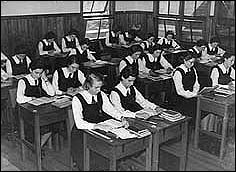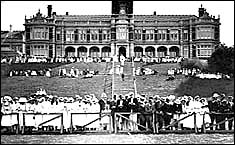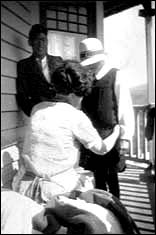Part 5 – Attending Intermediate And Secondary School In The Cities Dorothy – 01/12/00
You can read the previous part in the Growing up in New Zealand 1925 – 1950 series here, or read the articles from the original Growing Up in New Zealand series.
A few intermediate schools in some cities Intermediate schools were first opened in 1922. They were called Junior High Schools and most were attached to secondary schools. In 1933 the term Intermediate School was officially used.
|
|
| Nelson College before the earthquake. |
Many continued to be attached to secondary school until 1960. Peter attended what was called the Preparatory School for Nelson College and thinks that this made the introduction to secondary school much less intimidating. The younger pupils attended the assemblies of the whole school. For Peter this meant that he went to a few assemblies in 1939 in the old brick building which after that was condemned because of damage in the Murchison earthquake in 1929.
Many pupils found the transition from Primary to High School rather traumatic, especially if they were country children going to boarding school in the city.
Manual training Intermediate school pupils and those in Forms 1 and 2 in primary schools received what was called Manual Training. Pupils had no choice about following the sexist role. Girls studied cooking and boys went to woodwork. Girls were taught sewing in their primary school classes, but all the sewing was done by hand.
The old Normal School in Christchurch had been changed from a primary School to a manual training centre. It had been built according to plans prepared in Britain and the classrooms all faced south and were cold and sunless, while the corridors which faced north were bathed in sunshine. This did not really worry us while we were cooking, but we thought how dreary it must have been for the children who studied full time in those classrooms in earlier times.
Anna recalls, "At sewing classes in the term before starting cookery at the Normal School in Christchurch each pupil made an apron and a headband – both white and with thread-work along the edge in the school colours of blue and navy. The old Normal School buildings were an impressive setting for the classes and the long classroom with a line of pupils at the long tables on either side was quite suitable for the purpose. I remember making oatcakes, apple dumplings, stuffed tomatoes and jam. Cookery was the main part of the course, but it also included skills such as setting a table."
Secondary education In 1901 the school leaving age was set at fourteen, but in 1944 it was raised to fifteen.
‘More important for boys’ Many parents believed that to give girls education beyond the compulsory age was a waste of money. "What is the point of giving girls education as they will only go and get married and never use it? It’s far better to spend the money on the boys." was a frequent comment.
Secondary schools There were few secondary schools in the cities compared with the number there are today. Most were single sex schools, either State schools, or private schools run by the churches. There was a co-educational Technical College at secondary school level in most cities, and usually at least one other co-educational State school.
Verna recalls that in Dunedin ‘the Tech’ taught music, art, and commercial practice, and most of the trades for future apprentices. Its teaching was of a high standard, but was not always considered as ‘desirable’ as High School.
The curriculum Once pupils were enrolled, in most schools they were expected to sit an entrance examination. They were put into classes which were streamed horizontally on the basis of the results of this test and reports sent in from primary or intermediate schools. There was no choice of subjects available in the classes. All students in the professional classes studied a set curriculum.
Latin was compulsory for the highest professional streams because it was required for Law and Medicine. Peter remembers that at Nelson College there were three professional classes, 3A(Latin),3B and 3C(both Geography) followed by 3AC (Agriculture and Commerce) and 3EW (Engineering and Woodwork).
Anyone who wanted to drop Latin at Christchurch Girls’ High School in the 1940s had to transfer to the lower stream of 3M (Modern) where geography replaced Latin, or take a Home Science course. CGHS taught no commercial course so girls wanting to take up office work went to Avonside Girls’ High School for a commercial course or went to a commercial college such as Digbys for a year of typing, shorthand, and book keeping.
Girls in all courses had clothing and cooking classes for one year, but the sewing in these classes in the 1940s was done by hand. Several women recall making a baby’s petticoat and a small child’s dress entirely by hand – probably mainly because there were not enough sewing machines for a class to use. It was not an experience the pupils have repeated since!
Barbara remembers the dedicated teaching of the nuns at the Catholic schools she attended, and the emphasis on training in singing, and the extra lessons in piano and elocution for those who could afford the extra fees. One of several excellent teachers was the famous Sister Mary Leo who later taught many successful singers including Dame Kiri Te Kanawa and Dame Malvina Major.
School assemblies The day at secondary school began with an assembly at which there was a prayer and a Bible reading and sometimes hymns were sung. This was followed by announcements and sometimes a visitor to the school would give an address. The rolls in some schools had grown till the pupils could not all be accommodated in the hall and there were separate junior assemblies or assemblies were held out of doors.
School uniform At secondary schools uniform was compulsory. Most girls wore a navy blue serge gym frock, with a long sleeved white blouse and a tie with the school colours, a navy blazer with a monogram on the pocket, and a navy felt hat in the winter or a panama hat in the summer, each with a distinctive hat band with the school monogram.
 |
| Fifth formers at Christchurch Girls’ High School in 1945. Click here for a larger version |
The length of the gym frock was stipulated in the school prospectus to be a certain length above the floor when the student knelt down. This was checked with a tape measure. Early in the period the belt was well below the waist, but in the thirties it went back to the normal waistline.
|
|
| Fixing the gymfrock belt in 1928. |
Fawn lisle or black woollen stockings and lace up shoes were required, but during the war with the shortage of clothing girls were allowed to wear three quarter grey woollen socks. As a great concession short sleeved blouses and white ankle socks were permitted in summer. Gloves had to be worn in the street, winter and summer, and detentions were given to girls seen breaking this rule.
Under the uniform girls had to wear navy bloomers and often did phys ed (physical education) in bloomers and blouse. For sport navy rompers were the rule in most schools.
Boys usually wore grey worsted shorts and grey flannel shirts, with the senior boys sometimes permitted to wear long trousers, a monogrammed school blazer, white shirt, sometimes with a starched collar, and school tie. Caps were compulsory for street wear, or boaters usually for prefects or senior students.
Uniform had to be worn for school groups taken to concerts or for theatre visits. It even had to be worn by the girls on the tramping club trips. Few schools had a special uniform for summer, so the girls remember having to go tramping in the heat in serge gym frocks and white blouses and regulation footwear. Some mothers made gym frocks in linen but keeping the pleats pressed was a demanding chore and the gym frock was often carefully placed under the mattress at night so that it would look tidy for the morning.
Great importance was placed by the schools on the appearance of the pupils. Both boys’ and girls’ hair had to be cut to the regulation length and girls with long hair had to tie it back in a ribbon or plaits.
Many people suffered badly with chilblains on their feet, hands or ears, but no uniform regulations were bent to allow for more protection for the sensitive areas which itched and caused a lot of discomfort.
Prefects The prefect system operated in secondary schools and prefects helped with duties and discipline. At Nelson College the head prefect after a meeting of prefects was allowed to give one or two strokes of the cane. Masters were allowed to give up to six strokes.
School sport Rugby, cricket and athletics were without doubt the most prominent sports in boys’ schools. Sport was compulsory unless a doctor’s exemption certificate was produced. At Nelson College senior boys had the option of playing tennis.
 |
| Athletic Sports at Nelson College Straining for the finish in the 100 yards championship race. Click here for a larger version |
Inter-house competitions were held and inter-school matches were a regular feature, sometimes involving travel to other cities. Each year a Quadrangular Rugby Football Tournament was held involving Christ’s College, Nelson College, Wanganui Collegiate and Wellington College.
 |
| The 1945 Nelson College 1st XV. Click here for a larger version |
At most girls’ schools basketball and hockey were the winter sports with tennis and swimming and lifesaving in summer.
Pat who was a gifted sportswoman recalls that girls at Christchurch Girls’ High School had the opportunity to play other city schools at tennis in the summer and either hockey or basketball in the winter. "Basketball was quite a different game from the indoor basketball now played. There were nine players in a team and each group of three was restricted to a third of the court. Netball is today’s equivalent. We didn’t play any schools outside Christchurch. Schools also competed in the prestigious annual life saving competitions for the Monica Thacker Shield held at the Tepid Baths.
"Earning points for your House meant a lot. These were awarded for both scholastic and sporting achievements and inter-house competitions.
"Table tennis and badminton were also played and we had swimming and athletic sports days. Heats for the athletics were sometimes held in Cranmer Square and finals at Lancaster Park – a welcome change from the usual routine."
St Margaret’s College also used Lancaster Park for their athletic sports.
 |
| St Margaret’s College athletic sports The seventy five yards senior race. Click here for a larger version |
When boys’ schools were established space was usually reserved for extensive playing fields. Girls’ schools, however, were built on smaller sections, especially when they were in the inner city. As the numbers increased extra buildings were added and the playing areas became much smaller. Christchurch Girls’ High School used the adjacent Cranmer Square for some activities. Jane recalled the limited grounds at Wellington Girls’ College.
|
|
| Christchurch Girls’ High School on the town site before the move to Riccarton. |
Privileges for senior pupils In the thirties comparatively few pupils continued into the Sixth Form and being a sixth former carried some status. There was often a special classroom for these seniors and they were permitted to eat lunch there.
Military training Many boys’ schools had a strong military tradition, and Cadet training was an important part of school life. More of that in a later article.
Looking back on their education Much of the teaching and testing emphasised rote learning. Many pupils later valued the grasp of the ‘Three R’s’ and memory training that resulted and found these a good basis for further study, but realise that this form of education did not give much training in independent thinking. Participation in sport was another highlight for many people.
Such pupils look back on their schooldays with gratitude and feel a strong loyalty to their old school.
Read more on New Zealand schools 1925-1950.







